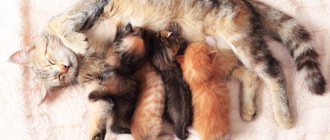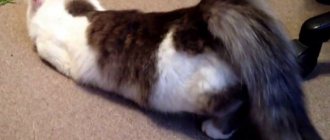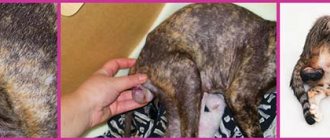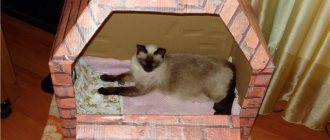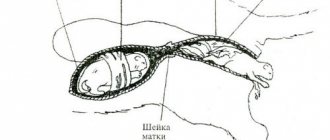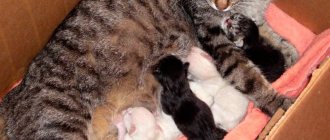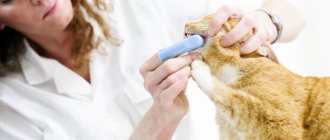Receiving affection from their pet cat and giving her their attention, most housewives, according to the site Koshechka.ru, simply call a doctor to accompany the birth of their four-legged pets. The doctor will help the cat herself, the kittens’ umbilical cord , and reassure the owner.
Umbilical cord in newborn kittens
Nature has not deprived every living creature of the maternal instinct, and the cat, naturally, was no exception.
We love and cherish our pets, but in nature, cats give birth to kittens on their own, they don’t have obstetricians, and no one helps. How does childbirth occur in cats?
Usually, a cat that “walks on its own” will find a secluded place before giving birth where it will be safe. When signs of labor appear, she takes refuge in the chosen place. After the water breaks, contractions begin. The first kitten is born on average an hour after contractions begin. If there are several kittens, they are born with a short time interval (from 10 minutes to an hour). The cat eats the afterbirth that appears, gnawing the umbilical cord on its own. Of course, she doesn’t do this close to the baby’s tummy. The time when the umbilical cord falls off in kittens is usually 3-4 days after birth.
The cat chews off the umbilical cord of kittens itself, but you can help her
Cat labor rarely lasts longer than 4 hours. This applies, of course, to healthy cats. In nature or an urban environment, kittens, and even their mother, face many dangers and difficulties; the mortality rate among street cats is high.
Childbirth in a domestic cat
It's a different matter for domestic cats! We love them, cherish them, care for them. And when “hour X” approaches, we worry almost more than the mother cat herself.
Pregnancy in cats lasts from 58 to 66 days. Owners should monitor the condition of the future mother cat, and even if there are no signs of illness, the cat is cheerful and easily carries kittens, it would be necessary to show her to a specialist at least once or twice during pregnancy.
For the birth itself, calling a doctor, according to ko6e4ka.ru, is not necessary. An attentive owner, who has read a little or otherwise become familiar with the peculiarities of the physiology of cats, is usually able to calm a woman in labor, accept newborns, and figure out how to cut the umbilical cord of a kitten. In addition, feeling and seeing a familiar, rather than a stranger, next to you, the cat will feel much calmer. Then the birth will go well.
Of course, for a cat that is too young, or, conversely, an elderly one, you should, if possible, invite a specialist. Also, qualified veterinary care for a cat whose pregnancy has been difficult will not hurt. Of course, owners of exotic and super-expensive cats, as well as kitten breeders, simply have to have a doctor present “by status.”
Do you trust doctors and their prescriptions?
Yes
18.41%
No
13.72%
I trust, but I check all medications for reviews on the Internet from people who have already tried them and only then do I start taking them.
50.9%
Yes, but only to appointments and doctors from paid clinics.
16.97%
Voted: 277
What does a caring cat owner need to do?
First of all, calm down yourself and prepare a “nest” for the future cat mother.
It is better to take a spacious box and cover it with a soft cloth, place it in a secluded and warm place. It’s good if the cat takes a fancy to the nest even before giving birth, this will add peace of mind to her.
If possible, the cat should be fed before giving birth. And of course, she should always have clean water in a bowl nearby.
You need to prepare several things for childbirth:
- Clean gauze or soft cloth;
- Scissors to cut the umbilical cord of kittens;
- Antiseptic;
- A pipette or a small rubber bulb;
- Threads.
In case complications arise (for example, the birth takes too long), you need to be on the safe side by having the phone number of a veterinary clinic ready, where you can call a doctor.
After the cat's contractions begin, you can help her by lightly stroking her tummy and back, but if the cat is irritated, then it is better not to disturb her. You can help a little if the cat cannot push the kitten out on its own (pull it by the paws or folds of skin on the body). It is better not to let the cat eat more than two afterbirths and throw away the rest. There should be as many afterbirths as there are kittens. After making sure that the kitten is breathing, it should be lightly rubbed and placed with its mother.
How to cut a kitten's umbilical cord
Often, when helping a cat during childbirth, owners behave calmly and deliberately, becoming stumped only when the question arises, what to do with the kittens’ umbilical cord?
Usually, as soon as the cat has lambed, it independently bites the umbilical cord of its kittens. Moreover, she does this precisely at the distance from the body at which she considers it necessary. However, if you are afraid for your pet or just want to make the task easier for her, you should, after disinfecting your hands and scissors, twist the umbilical cord with a flagellum and cut it off at a distance of 2-3 centimeters from the tummy, first tying it with a thread soaked in alcohol.
If during pregnancy and during the birth process the cat did not experience any difficulties, then the umbilical cord should dry out within seven to ten days.
If the kitten has an umbilical cord left for longer than two to three weeks (it does not decrease in size or fall off), then you should contact a veterinary clinic. There is always a risk of rotting of the part of the umbilical cord that has not yet dried out. Only in this case can you begin to treat its end with hydrogen peroxide, be sure to consult with a specialist.
Thus, by calmly and carefully monitoring your cat during pregnancy, without giving in to panic during labor, you will help her give birth to healthy kittens and get the opportunity to admire the happy mother cat and her cute babies.
Ivanova Alexandra - especially for Koshechka.ru - a site for those in love... with themselves!
Of course, for a cat that is too young, or, conversely, an elderly one, you should, if possible, invite a specialist. Also, qualified veterinary care for a cat whose pregnancy has been difficult will not hurt. Of course, owners of exotic and super-expensive cats, as well as kitten breeders, simply have to have a doctor present “by status.”
If you decide to do something like breeding kittens or are forced to give birth to your own cat, then you should know some of the features of this process. In principle, nature has decreed that a cat, for the most part, copes with its own childbirth on its own.
If the outcome is successful and your pet is in enviable health, your participation in the birth process will be minimal. If you are not sure that, if necessary, you will be able to provide qualified assistance to your pet, it is advisable to call a veterinarian who will help you cope with this task.
In addition, you can start giving birth by enlisting special literature, which will not only describe the step-by-step processes of labor, but also information on how to cut the umbilical cord in kittens.
In principle, it is not so difficult to understand that your cat is giving birth: she begins to abruptly look for some secluded place. Cats are not social animals, and when it comes to processes such as childbirth and illness, they prefer to endure them alone.
Stages of development of newborn kittens
A lot of changes happen in the first two weeks.
During the first two days after birth, kittens' umbilical cords fall off.
After the first week, their weight doubles, and around the seventh to tenth day, their eyes and ears open.
The cat literally never leaves her babies. After feeding, she licks them with her warm tongue to stimulate the digestion process. She eats kitten feces. In this way, the cat tries to keep its nest clean so that potential enemies do not come to the smell.
When the kittens are three weeks old, you can begin to pick them up and teach them to interact with humans. If you gently hold them from time to time as adults, they will feel comfortable and confident interacting with people. However, do not hold them in your arms for too long, so that the cat does not begin to worry about her cubs.
Cat giving birth
So, you have decided to have fluffy feline offspring. It’s a little easier for cat owners - they invited the cat to “visit” for a couple of days, two months later they received kittens, and after another month and a half they chose the most beautiful and healthy one. But it’s not so difficult with cats either - nature has provided for everything. If your cat is noticeably rounder, arm yourself with the following knowledge.
It is necessary to prepare the box, cover it with a blanket, oilcloth and diaper, and also prepare additional diapers for a change.
In case the cat does not gnaw the umbilical cord or rupture the amniotic sac.
If you are going to help a cat, then you must do this with gloves.
How to understand that a cat is giving birth?
The cat becomes restless, hides and looks for a place for itself, even if it has long been accustomed to the box. She can follow her owner and meow invitingly. Examine the abdomen; before giving birth, the breasts fill with colostrum and become greatly enlarged. Notice if there are yellow or blood stains on the carpets or sofas - this is a sign that your water is breaking. As a rule, this happens a couple of hours before the birth itself, but it is possible right before it.
If you notice that the cat is tense and the abdominal muscles are contracting, then the process has begun. Transfer your pet to the box and pat its belly. If the attempts are rare, it means that the fetuses are only moving towards the uterus - this can last several hours. When the pushing becomes more frequent and longer, you can help the cat: place your palm so that when pushing, the cat rests on it with its hind legs. With your second hand, a little stronger than usual stroking, as if pushing the kittens from the chest to the tail.
Kittens come out head first. Sometimes they may be in the bubble they were in in the "mother's" belly. The cat bursts the bladder, gnaws the umbilical cord, and after a couple of minutes the placenta comes out. Kittens are born 30 minutes to an hour apart. If the delay is longer, then one of the complications could occur:
If the attempts become more frequent and continue for more than 3-4 hours, but the cat does not give birth, perhaps they are too weak to push the kitten through. Call a veterinarian, and if this is not possible, give an intramuscular injection of oxytocin (1 ml, no more, and only on the advice of a doctor). This will increase the effort and speed up labor.
Examine the bubble carefully: if the kitten is in it sideways rather than head first, lubricate your fingers with Vaseline and gently push it back. During the next attempts he will turn over.
The cat does not rupture the amniotic sac
The kitten came out, but the cat does not burst the bubble, do it yourself with sterile scissors as quickly as possible, and make sure that the kitten breathes and meows.
The cat does not chew the umbilical cord
If after birth, the cat does not pay attention to the baby, you will have to do everything yourself: tie the umbilical cord 4 cm above the base and cut it. Dry it with a towel and apply it to your mother's breast.
The kitten's head appears, but the cat cannot push it further. It is necessary to help because it can be suffocated by muscle contraction. Lubricate your fingers with Vaseline and insert into the birth canal, gently rotating your finger around the kitten's head, this will relax the vagina. Or feel the front paws, hook the “baby” under them, and very slowly and carefully, pull him towards you with each contraction, but not up or down, but parallel to the floor, so as not to damage the vagina.
The main thing is not to be afraid of anything and act decisively. More often, kittens die during childbirth if we are inactive, afraid to provide help, and not because of our intervention.
Genera of Scottish fold and straight-eared cats.
If the mating is successful, the Scottish cat becomes pregnant and signs of this can be detected at 3-5 weeks. The nipples turn pink and swell. The cat eats and sleeps more. And in the period from 56 to 71 days you need to wait for birth. The birthing area must be prepared in advance so that the cat gets used to it. This could be a box or drawer of such a size that she can comfortably fit in with her kittens. However, despite the pre-prepared place, the cat may worry a few days before giving birth, looking for a place that is more suitable in her opinion for the nest. At the same time, she tries to climb into the closets, into the sofas, into the bed. You can try to block access to these places and accustom her to the place you have prepared, but sometimes this does not work. And sometimes I had to agree with the cat and place her nest where she wanted (for example, on the bottom shelf in the closet).
About 5 days before the expected birth, you should start measuring the temperature of the expectant mother. On the day of birth, a rectal measurement shows a decrease in temperature to 36.7 C (normal temperature for cats is 38.3 C - 38.9 C). In the first phase, the cat begins to have contractions, her breathing and pulse quicken, she rushes about, often changing position. This period can last from 12 to 24 hours. If more, you need to contact your veterinarian. In the next phase of labor contractions, strong pushing begins, which simultaneously sets in motion the muscles of the abdomen and diaphragm and pushes the fetus into the vaginal canal. In this case, a small amount of liquid may be released. At the vaginal exit, part of the amniotic sac covering the kitten is shown. At this time, the cat lies on its stomach or side; if the fetus is large, then it stands and squats on its hind legs. From the moment when the kitten’s head appears at the exit of the birth canal until its full appearance, approximately a quarter of an hour passes. If there is a delay, you should urgently call a doctor. In classic presentation, the kitten is positioned with its head and front paws facing the exit. But almost very often kittens walk with their hind legs, which is also considered normal and, if the bladder does not burst, does not lead to complications in childbirth. As soon as the kitten is born, it is necessary to immediately release it from the amniotic sac. Usually the cat independently treats the baby, gnawing the membranes, intensely licking the kitten's face, cleaning its nose, mouth and body, thereby stimulating its breathing and blood circulation, causing the first separation of feces, after which it gnaws the umbilical cord. The kitten takes a sharp breath, its lungs expand, and it begins to breathe. Sometimes inexperienced or shy cats don't do this. Then you need to help her break the bubble on his face, wipe his face and body with a clean napkin. If the cat has not chewed the umbilical cord, it must be cut with scissors at a distance of about 2 cm from the abdomen, the end of the umbilical cord should be grasped with two fingers and treated with an antiseptic. After this, the kitten should again be offered to its mother for further licking. The umbilical cord should not be cut until the afterbirth has come out. The placenta (baby place, placenta) must come out after each kitten. Cats usually eat them, but eating too many placentas can cause diarrhea, so it's best not to let your cat eat more than 2 placentas. It is imperative to ensure that the number of placenta is equal to the number of kittens born. A failed placenta may appear after a few hours, but if this does not happen, give one injection of oxytocin - 0.2 ml. If this does not help, you need to contact a veterinarian. The remaining afterbirth inside the cat will decompose. The cat rests for some time after the birth of a kitten, then contractions and pushing resume, and the next kittens are born. Between the birth of subsequent kittens, it takes from 15 minutes to 2-3 hours. At the end of the birth, the cat finally calms down and feeds her kittens. She needs to be given a clean bedding and left alone. In the future, you need to make sure that she licks the kittens well, that they are clean and eat well.
No comments yet!
Featured Articles
Hair coming out after childbirth what to do
Girls, after childbirth your hair falls out a lot! What should I do? Yes, yes, I have further.
Feeding. Transition to solid foods
After three weeks, kittens should be weaned off their mother's milk by offering them solid food. Gradually introducing your babies to solid food will benefit both their health and the health of your cat. Receiving a small amount of food from your hands, the kittens will suckle their mother less and less each time. However, do not forget that the process should be gradual.
Buy canned or dry food for kittens, which you will first soak in water. Place a tiny piece of food on your finger and place it under your kitten's nose or lips.
For more information about what foods you can feed a small kitten, read our article: “What to feed a kitten? List of products by age."
How to treat a newborn's navel.
There is nothing more beautiful in the world than the birth of a child. Parents experience great joy that cannot be compared with anything. But when you take a child in your arms and, having admired him enough, a large number of questions begin to appear: what to do and how to do it correctly, how to care for a newborn, how to treat the navel, how to bathe a newborn. In this article we will look at the topic of treating a newborn's navel.
Care for the newborn in the maternity hospital will first be carried out by the maternity hospital's health workers. While the young mother still does not get out of bed after giving birth, the pediatrician and other health workers often look into your room and, if necessary, change the baby’s clothes, change his diaper, swaddle him, etc. From the outside it looks very simple. And, when, finally, the mother approaches her baby to carry out hygiene procedures, she is overcome by uncertainty - will I be able to do everything right myself. But, dear mothers, do not be afraid. Just a couple of days - and you are a real pro in this matter. When you return home with your child, everyone will look at you and think that you have been doing this all your life.
In fact, belly button care is very simple. After cutting the umbilical cord, a small umbilical cord remains on the baby's tummy. After 3 – 10 days it disappears on its own (usually this happens on the 4-5th day). At first, ichor oozes from the navel. And in order to prevent infection of the wound, it should be properly cared for. Normally, a newborn's navel heals within 3 weeks.
You can buy a British kitten from us. Minsk. +375 (29, 44) 7-222-444
Development of kittens by weeks and months
| First two weeks |
|
|
|
|
|
|
| Two to four weeks _ |
|
|
|
|
|
|
| Four to eight weeks _ |
|
|
|
|
| Eight to fourteen weeks _ |
|
|
|
|
|
| Six to twelve months _ |
|
|
How to properly trim the umbilical cord. How to properly cut the umbilical cord in kittens
How to properly cut the umbilical cord? Pregnancy and childbirth of British cats.
Cottage cheese must be present in the diet. if the cat does not eat vitamins with calcium. calcium gluconate. After the birth of the placenta, the midwife checks the condition of the birth canal for ruptures. If the cat is from colder areas. then the spots are not darker. and if the warm ones are lighter. Often. The umbilical cord is cut before the first torsion on the baby's side. counting.
that in this way problems are cut off from him. In natural childbirth, there is only one way to cut the umbilical cord after that. how the blood pulsates and the placental transfusion ends. The cat answers him. pressing the front part of the body closer to the floor and lifting the back part up. Many cats in the process of giving birth eat the placenta immediately after the birth of the kitten.
If you are calm. passive person. then a light-colored cat would be more suitable for you. But after childbirth, caring for and feeding a newborn becomes a real problem. Writer Minsk Home veterinary reference book for cat owners D. The veterinarian should help in case. if the time from the birth of one baby to the next exceeds 34 hours.
Mastitis can also be caused simply by a bacterial infection after mechanical damage to the mammary gland. For example. happens. that kittens damage their nipples with their claws while sucking. and also be a consequence of endometritis. At the height of heat, a cat takes characteristic poses in front of its owner or cat.
nearby. Ideal for students. English language training available. like from the very beginning. as well as improving conversational practice and grammar for Intermediate and Advanced levels. Dispute about that. Where did our domestic cat come from? was finally resolved by a new method of studying DNA.
The modern system of childbirth has been worked out for decades and it would seem. Well, what else can be improved. think up or change. If the cat does everything right. You cannot interfere with this process. if. How to deliver a cat. Besides. You can take care of childbirth by enlisting special literature.
where not only the step-by-step processes of labor will be described. but also information about that. how to cut the umbilical cord in kittens. The average gestation period for cats is about 65 days. For example. the cat will not be able to produce milk. if she doesn't eat 2 3 kittens' placenta. Bubble with your fingers. and the umbilical cord.
Once I cut the umbilical cords of the kittens of a very old toothless cat. Out of fear, I didn’t even disinfect the scissors. Thank you. Now I know what I'm doing right. I need to take some napkins. Then a clamp should be applied. cut the umbilical cord with clean scissors. In wild and stray cats. They also occur in old animals. mostly. in the spring and
If you decide to do something like breeding kittens or are forced to give birth to your own cat, then you should know some of the features of this process. In principle, nature has decreed that a cat, for the most part, copes with its own childbirth on its own.
If the outcome is successful and your pet is in enviable health, your participation in the birth process will be minimal. If you are not sure that, if necessary, you will be able to provide qualified assistance to your pet, it is advisable to call a veterinarian who will help you cope with this task.
In addition, you can start giving birth by enlisting special literature, which will not only describe the step-by-step processes of labor, but also information on how to cut the umbilical cord in kittens.
In principle, it is not so difficult to understand that your cat is giving birth: she begins to abruptly look for some secluded place. Cats are not social animals, and when it comes to processes such as childbirth and illness, they prefer to endure them alone.
Just before giving birth, do not be nervous under any circumstances, since the cat is your favorite, and in any case, your excitement will be transmitted to her, which is undesirable in her situation.
A cat, just like any woman, will initially suffer from contractions, which will quickly turn into pushing. It is worth noting that the duration of labor in a cat is much shorter than in a human. However, you will have to be patient. After the attempts begin, kittens will appear one after another.
It is advisable not to touch the cat after giving birth and not to allow strangers near it. If you're wondering when kittens' umbilical cords fall off, it usually happens within 2 or 3 days.
Do not disturb the cat under any circumstances while the kittens are still very small and blind. It is advisable to provide the new mother and her children with a separate nook with a special box into which the cat can easily jump, and from which the kittens, which are too young, will not be able to get out.
You should not look into the kittens’ box once again, and under no circumstances should you pick them up until they begin to crawl out of their birth “nest.” This will make your cat nervous, which is contraindicated for her right now.
The most you should do is provide your cat with regular food and a calm environment.
When can you take kittens away from your cat?
At this time, you may want to find new homes for the kittens, but do not forget that kittens gain very valuable experience in the company of their mother and littermates. It is this period that plays a decisive role in whether they, already as adult cats, will be able to find a common language with their relatives. Kittens should not be separated
from each other until they are at least 12 to 14 weeks old.
Since, by communicating with each other and the mother cat, kittens gain communication skills and basic experience in using the toilet, scratching post, etc.
Vet clinic
International Scientific Center for Treatment and Rehabilitation of Animals ZOOVET
Free initial appointment with a therapist or surgeon on weekdays from 12:00 to 16:00!*
A veterinary center that emphasizes inpatient treatment and rehabilitation. The center's staff includes rehabilitation doctors, specialists in caring for animals after operations and difficult therapeutic cases.
The international scientific center for the treatment and rehabilitation of animals ZOOVET is one of the few veterinary clinics in Moscow that provides veterinary services to almost any type of animal kept in apartments, be it cats, dogs, rodents, reptiles or birds.
Located in a separate building on 3 floors with a total area of more than 1000 sq.m., the ZOOVET animal treatment and rehabilitation center is today one of the largest veterinary clinics in Russia.
The animal treatment and rehabilitation center includes: therapeutic rooms, two separate operating rooms, a post-operative unit with comfortable enclosures, visual diagnostic rooms, a veterinary pharmacy, and a comfortable and large waiting hall. Thanks to this, at the ZOOVET veterinary center, your pets can take advantage of all the achievements of modern veterinary medicine.
The ZOOVET Animal Treatment and Rehabilitation Center has all the necessary equipment to conduct a complete diagnosis and accurately diagnose pets. The center employs highly qualified visual diagnostic specialists. It has its own veterinary laboratory. allowing laboratory tests to be performed in the shortest possible time.
Special mention should be made of surgical services. carried out at the ZOOVET veterinary center. An anesthesiology team works for each operation. If necessary, a ventilator and oxygen are used. The patient’s condition is monitored by monitors, which allows operations of a high degree of complexity even for patients in serious condition.
The animal treatment and rehabilitation center ZOOVET has emergency veterinary care, a 24-hour dispatch service and several doctors on duty. Emergency doctors are fully equipped with the necessary drugs and consumables. You can also receive the following veterinary services without leaving your home: ultrasound, ECG, collection of material for laboratory tests, as well as some types of surgical operations and other services.
The International Scientific Center for the Treatment and Rehabilitation of Animals ZOOVET maintains close scientific and practical contacts with specialists from veterinary clinics in Europe. Veterinary center specialists periodically undergo internships in foreign veterinary clinics and medical institutes.
The ZOOVET Veterinary Center participates in the postgraduate education program.
The center's specialists are regular speakers at Russian and international veterinary conferences.
The provision of veterinary services in our center is provided on the basis of a Veterinary Services Agreement.
We work around the clock without weekends and holidays!
Our phone
We are always happy to help you!
Regular feeding
While the kittens were lying in the above-mentioned basin, I found on the Internet that it is necessary to feed the orphans with a special cat's milk substitute, sold in veterinary pharmacies. But 10% cream and regular high-fat milk are also suitable; sometimes you need to add 0.5 liters of raw yolk and 4 teaspoons of granulated sugar. I immediately went to the store.
I used glass pharmacy vials from penicillin as bottles, and the rubber parts of ordinary pharmacy pipettes became the nipples. They calmly stretch onto the wide neck of the bubbles. But you need to immediately purchase about 20 pipettes. They are sometimes torn, sometimes lost, sometimes spoiled by the kittens’ rapidly growing teeth.
The milk needs to be heated, you can do it for 3-5 seconds in the microwave, check before feeding to see if it is too hot - in general, everything is the same as with human children. And, of course, you need to wash and dry the nipple pipettes and bubbles after each feeding. It is convenient to pour the daily portion of milk into a separate jar with a plastic lid, store the jar in the refrigerator, stick a 10 ml syringe with a needle into the lid, and use it to pour milk into the bottle through a hole in the nipple. And you can draw milk from a jar with a syringe without a needle. This is more convenient than aiming milk from a tetra pack or can into a narrow penicillin bottle, then pulling the pipette onto the filled bottle. The syringe and needle should also be washed regularly.
The volume of a kitten's serving increases from 10-20 ml of milk in the first week to 100 ml by 3-4 weeks; they set the frequency of feedings for themselves. By two weeks, the 10 ml penicillin bottle can be replaced with a larger volume bottle, for example, a 20 ml pharmaceutical bottle of bacteriophage, and by three weeks - a 100 ml bottle of alcohol, if the number of kittens is more than one. Kittens eat depending on the weather - sometimes every hour, sometimes every 3-4 hours in sleepy, cloudy weather. When they are full, they lean away from the nipple. At night, our kittens slept decently, giving me a rest from midnight until exactly 8-10 in the morning. Only on the first night they made me stay awake, eating every hour.
It is convenient to feed kittens in your arms, with their back facing you, holding them with one hand under their front legs and belly, and holding the bottle with the other. A hungry kitten will fiercely cling to the bottle, preventing itself from sucking on the nipple, so at the beginning of feeding you need to hold your paws, and then when the kitten is calmly sucking, let go, then he will wrap his paws around the bottle. Visually or on scales, monitor the growth of the babies, by a week the weight should double and reach about 250 g, at 2 weeks - about 400 g, per month about 600-700 g, at 2 months - about 1300 g, by 6-8 months it reaches the size of an adult cat . If the kitten is not gaining weight, is lethargic and weak, go to the vet immediately!
Should puppies' umbilical cords be cut?
Receiving affection from their pet cat and giving her their attention, most housewives, according to the site Koshechka.ru, simply call a doctor to accompany the birth of their four-legged pets.
The doctor will help the cat herself, cut the kittens’ umbilical cord, and reassure the owner. We love and cherish our pets, but in nature, cats give birth to kittens on their own, they don’t have obstetricians, and no one helps. How does childbirth occur in cats?
Usually, a cat that “walks on its own” will find a secluded place before giving birth where it will be safe. When signs of labor appear, she takes refuge in the chosen place. After the water breaks, contractions begin. The first kitten is born on average an hour after contractions begin.
Cat labor rarely lasts longer than 4 hours. This applies, of course, to healthy cats. In nature or an urban environment, kittens, and even their mother, face many dangers and difficulties; the mortality rate among street cats is high.
It's a different matter for domestic cats! We love them, cherish them, care for them. And when “hour X” approaches, we worry almost more than the mother cat herself.
Pregnancy in cats lasts from 58 to 66 days. Owners should monitor the condition of the future mother cat, and even if there are no signs of illness, the cat is cheerful and easily carries kittens, it would be necessary to show her to a specialist at least once or twice during pregnancy.
Do I need to cut the umbilical cord when giving birth to a dog?
How to properly cut a puppy's umbilical cord?
No, don't. And in general, it’s better not to interfere with this “sacrament.” Don’t disturb the dog, he’s already stressed. Place a bowl of clean water nearby and leave it alone.
Believe me, she will feel more confident without you. Nature laid all the necessary knowledge in her head.
She will gnaw the umbilical cord herself. And he will also “clean up” to the best of his ability in his nest. The placenta eaten by a newly whelped bitch is also not nonsense, but a completely logical action. In this way, the dog replaces the nutrients lost during pregnancy in its body and stimulates milk production.
If you are really worried, be there and just listen. If he fumbles and is silent, then everything is fine..)
Do I need to cut the umbilical cord when giving birth to a cat?
How to properly cut the umbilical cord in kittens?
As for the umbilical cord, the cat will do everything herself. My parents always kept cats, and as far back as I can remember cats always handled childbirth on their own. Or another cat helped them. We've had several of them.
If the cat is purebred like mine, then you will have to cut the umbilical cord yourself and remove the afterbirth. Pedigree cats don’t do this, and I don’t want my cat to eat this bloody stuff, they might get sick from it. Step back a couple of cm from the kitten's belly and clamp or tie the umbilical cord with a thread, cut off the excess with scissors, treat the scissors with alcohol or vodka first, when you cut the umbilical cord, treat the wound with chlorhexidine, the cat will do the rest, lick the kitten.
On what day does the umbilical cord fall off?
This page contains the most popular posts and comments from our users on the topic “On what day does the umbilical cord fall off?” This will help you quickly get an answer to your question, and you can also take part in the discussion.
It doesn’t have a specific period, so don’t worry, it will disappear when needed. I don’t even remember how long it took, because I wasn’t paying attention))) but I left the maternity hospital and it still hasn’t fallen off at home.
After 2.5 weeks it disappeared. The navel completely healed after a month and a half. The doctor said that the umbilical cord is thick, so it will take a long time to fall off. And so it happened.
If the umbilical cord has not fallen off yet, can you bathe the baby and lay it on the tummy? And on what day does the umbilical cord usually fall off? They didn’t cut it off for us in the maternity hospital.
We were also discharged with this brace, it fell off on the fifth day... You can bathe with the brace... Now, if it doesn’t fall off, you need to ask the doctor, the patronage comes to them with a question... In the maternity hospital they said it could be on my stomach, I put it... Maybe that’s why it flew off))) just then lots of greenery
Oh! Are these the new rules for these girls? I didn't even know! My Toshka’s umbilical cord was cut off in the maternity hospital on the 3rd day! When they were discharged home on the 6th day, it was already possible to bathe them and put them on their stomach... Now they send everyone home without cutting them off, right?
